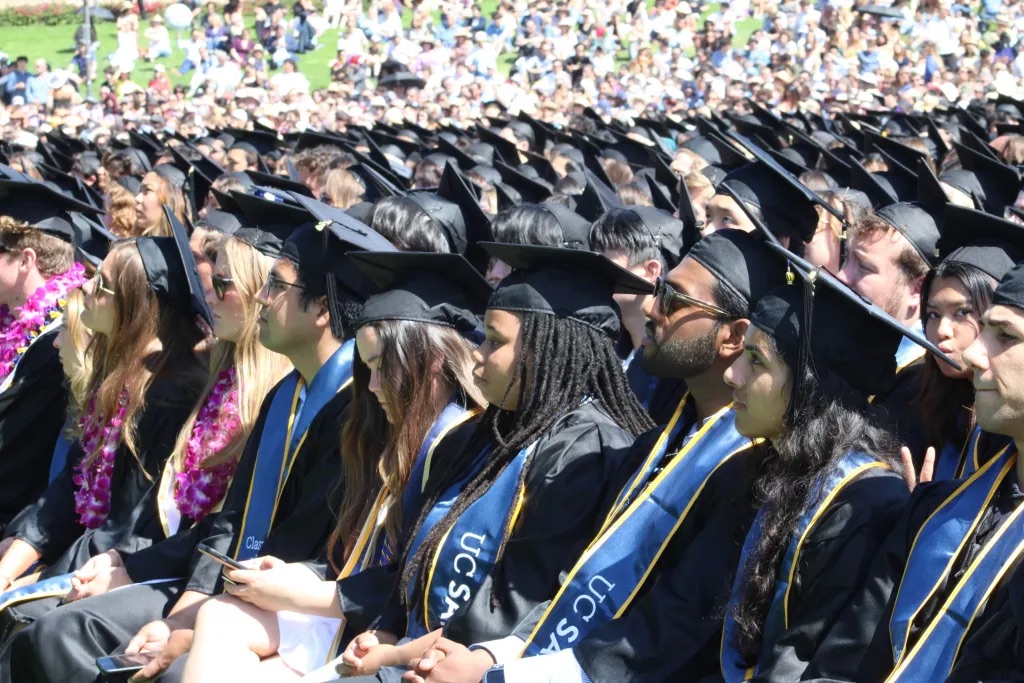
UC Santa Barbara bids farewell to the class of 2024 across eight ceremonies on June 15.
Credit: Rebecca Caraway / Noozhawk.com
Last weekend I had the moving experience of attending one of the last of dozens of commencement ceremonies held on various campuses of California’s massive system of public higher education this academic year.
The one I went to took place at a scenic site at the University of California, Santa Barbara next to the landmark UCSB Lagoon and the glittering Pacific Ocean beyond.
Over 6,000 undergraduates received their bachelor’s degrees over the weekend — requiring the commencement to be staged in multiple ceremonies over two days to accommodate all of them.
The sight of thousands of students walking — or ambling or skipping — across the stage offered a graphic representation of what California has been able to accomplish on a scale not seen anywhere else in the United States, or perhaps the world.
I was moved not only by the sheer numbers, but also when I reflected that almost all of them had missed out on their high school graduation because of the pandemic, and then had to start their college education by studying remotely from home. And then this year, until just a few days earlier, even the location of the event had been in doubt against the backdrop of possible protests triggered by the Israel-Palestinian conflict.
I was also moved because my daughter was among the graduates.
She was just one of the over 60,000 undergraduates who received their degrees from the 10-campus University of California system over the last few weeks — and the more than 100,000 who received similar honors at the 23-campus California State University system.
As the graduates filed by, with names reflecting a dazzling kaleidoscope of different ethnicities and backgrounds, I thought about the great effort it took to get each one of them to the finish line — effort on the part of the students themselves, of their families and of the institutions they attended.
I confess that when my daughter enrolled as a freshman four years ago, I worried about the quality of the education she would receive — simply because of the huge numbers of students most UC and CSU campuses have had to take on. I had the same concerns when my son enrolled at UC Irvine a few years earlier.
I need not have worried.
At a celebratory dinner a few hours after her graduation ceremony, I asked my daughter to name the worst class she had taken — and the best. She easily remembered the worst one, but then, with equal facility, named four courses — psychopharmacology, psychopathology, population health, and the history of architecture in the U.S. — she said were outstanding ones. She enthusiastically described each of them, including the professors who taught them. It was exhilarating to see a young person, and my daughter no less, so excited about learning and scholarship.
My son had a similar experience at UC Irvine, where he majored in data science, and then, partially as a result of the pandemic, stayed for an extra year to get his master’s degree in statistics. He now has a job at Google.
Both of them say they got a high-quality education on their campuses. This was achieved despite the huge increases in enrollment in recent decades.
UC Santa Barbara this year, for example, awarded about 50% more undergraduate degrees than two decades ago.
I could easily see the impact these increases had on my daughter and her friends. Before moving to an off-campus apartment, she lived in a three-bedroom campus apartment with six other students, with two students in each of two tiny bedrooms, and three in the small room my daughter was in. It was tough to get into all the classes she wanted to take.
But she made it through, pandemic and all.
Unbeknownst to them, what she and my son benefited from were the fruits of California’s ambitious Master Plan for Higher Education, drawn up in 1960, which aimed to provide postsecondary opportunities to “anyone who could benefit.”
At the time, only 11% of adults of prime working age had bachelor’s degrees. As researchers from the Public Policy Institute of California point out in a just-issued paper, by 2021, that number had risen to 37%. The state has now set a goal of 40%, which according to the authors, should be much higher.
So enrollments are likely to increase, and there obviously is still work to be done to make sure all students are able to take full advantage of what our public universities have to offer. That includes making sure they graduate not only within a reasonable amount of time, but graduate at all.
The overall four-year graduation rate for UC is 73%, a respectable number, but California can do better — especially among low-income students and those from underrepresented groups who graduate in significantly lower numbers. At the California State University system, which serves an older student body, many of whom are working, graduation rates are even lower.
But California is at least on the right track. Rather than simply creating degree-granting factories, the state appears to be able to offer a high-quality academic experience to its students — one that they, and California, will benefit from for many decades.
Louis Freedberg is Interim CEO of EdSource.
•••
The opinions expressed in this commentary represent those of the author. EdSource welcomes commentaries representing diverse points of view. If you would like to submit a commentary, please review our guidelines and contact us.

دیدگاهتان را بنویسید